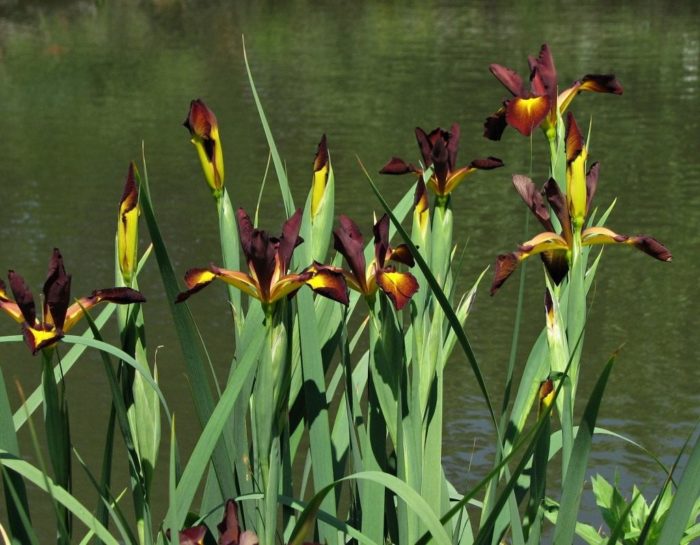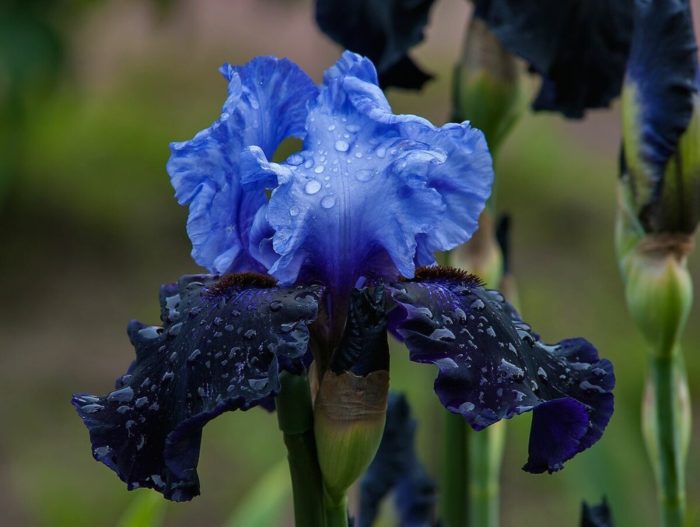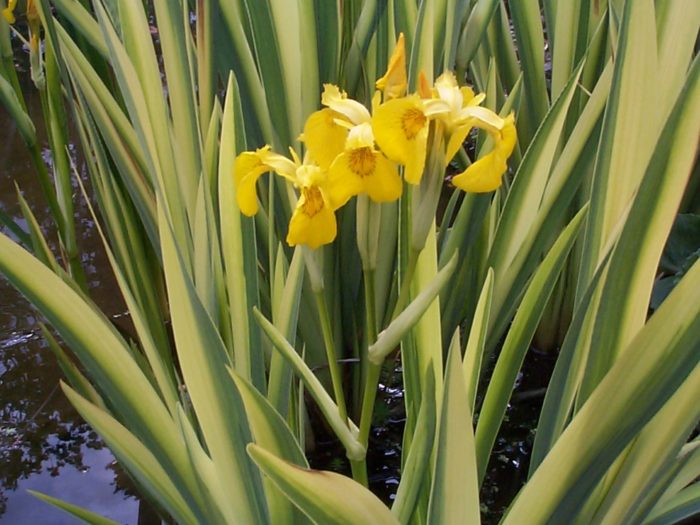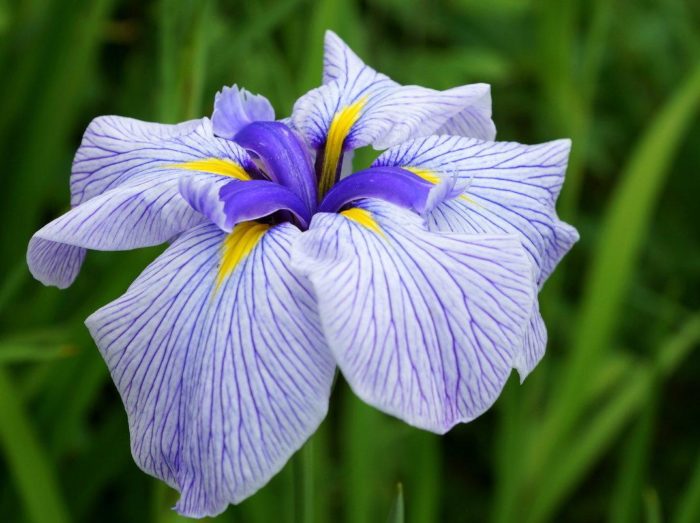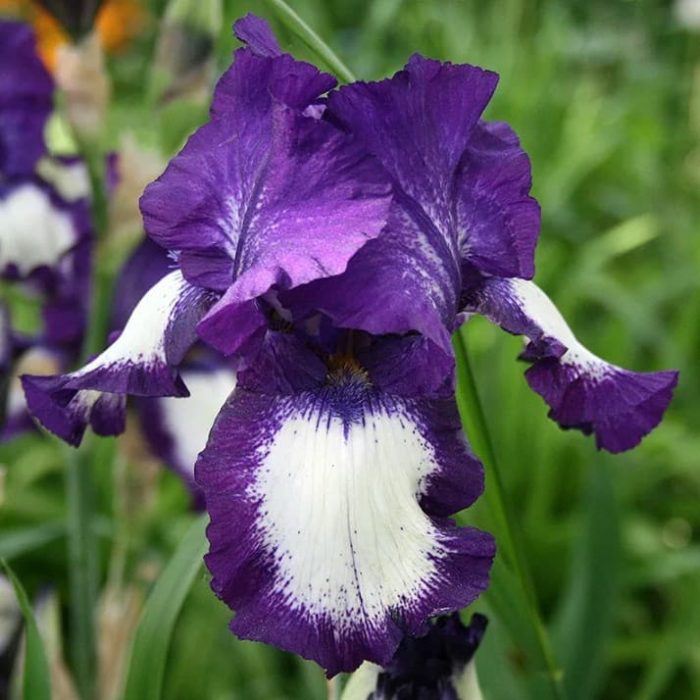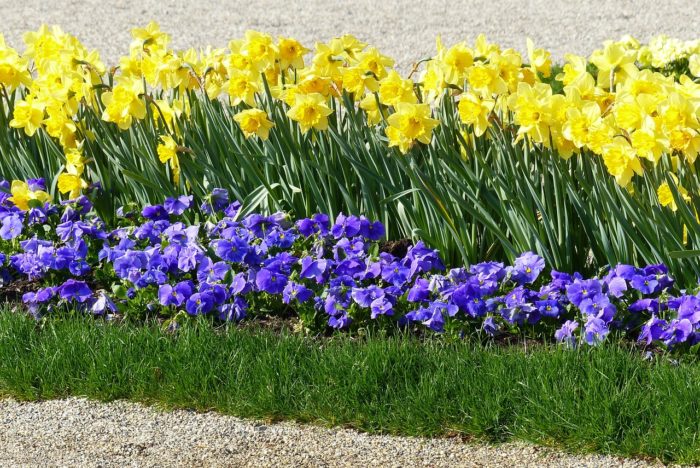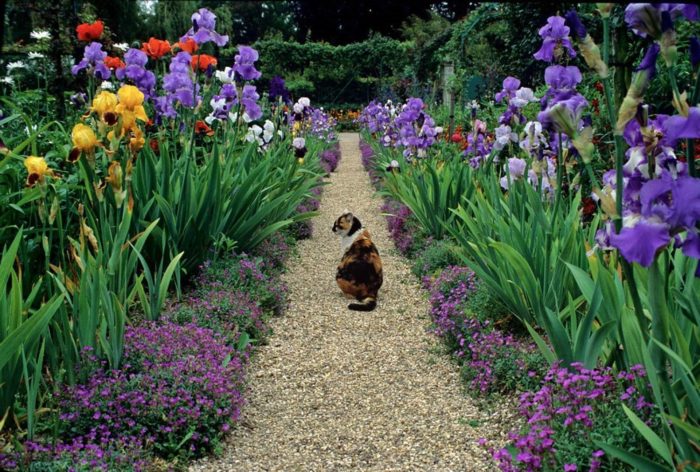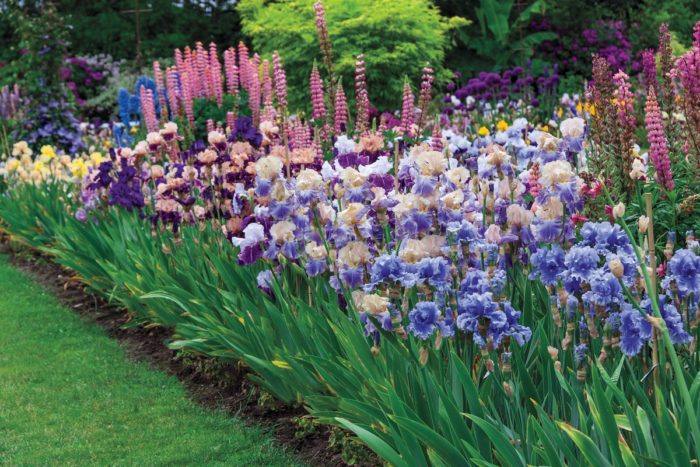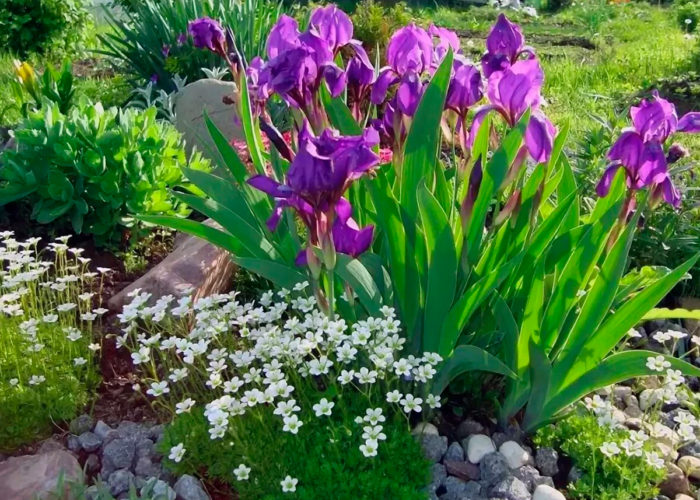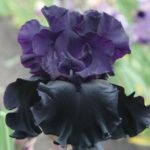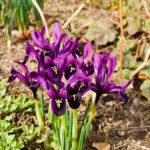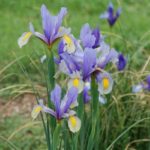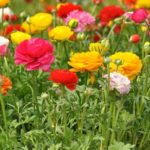Irises are well-known perennial flowers that are very popular among landscape designers. They are highly decorative, undemanding to care and can be combined with many other garden plants. Currently, more than 700 varieties of these flowers are known. They differ in the size of the buds, the height of the bush and the shade of the petals. Due to their decorative properties, irises are often used in landscape design.
- What varieties are used
- Bearded irises
- Iris Spuria
- Non-bearded irises
- Iris Swamp
- This perennial plant grows up to 110 centimeters. Its green leaves reach a length of 80 centimeters. The flower is characterized by small buds. But they grow in significant numbers.Siberian iris is often used in landscape design. This is due to its exquisite appearance and beautiful petals of different colors. This culture is especially often used in mixborders.
- Iris Japonica
- Iris Germanica
- Are tall irises suitable?
- Design Tips
- How to care for plants
- Examples of using irises
- border decoration
- Flowerbed decoration
- Other uses
What varieties are used
These perennial flowers come in amazing variety. Many varieties are obtained artificially and are classified as hybrids. All subspecies differ in petal color, size and flowering time. They are short, medium and tall. There are also miniature varieties that belong to the dwarf variety. Therefore, gardeners can choose attractive solutions for their plot.
Bearded irises
This group includes varieties of different sizes, including dwarf ones. They got their name from the dense layer of hairs that covers each bud. Plants have a standard structure.
Bearded irises are characterized by dense petals covered with a waxy coating. The shade is influenced by the crop variety. These irises come in scarlet, purple, and white. Sometimes the petals have an unusual shape and have wavy or patterned edges. Plants bloom at the end of May. This period lasts 2 weeks.
Iris Spuria
These irises reach a height of 90 centimeters. They are distinguished by sword-shaped leaves and delicate petals. The size of the buds is affected by the variety. In addition, Spuria irises are distinguished by a variety of shades. This culture grows well in any soil - dry and waterlogged.
This category includes grass-like irises and other varieties.Flowers of this variety are usually found in the wild. They began to be used in garden plots relatively recently. However, this culture has already become widespread because it is considered unpretentious.
Non-bearded irises
This category of irises includes many subspecies that grow up to 20-100 centimeters. They are characterized by sophistication, which can be seen in the petals of the buds. Varieties differ in color. It comes in white, yellow, blue, and purple. However, there are no hairs on the petals of such crops.
Certain varieties of this group are distinguished by high requirements for soil composition. Therefore, it will not be possible to plant them in any garden plot. At the same time, non-bearded irises develop well in temperate climates. They do not require warm weather.
Iris Swamp
This crop can reach a height of 2 meters. It is characterized by huge sword-shaped leaves and massive buds. The petals are usually yellow in color, but sometimes have a white or cream tint. Swamp iris is often used to decorate ponds. However, plastic containers are often used for planting, which help to avoid excessive growth of the crop.
The Variegata variety is considered a particularly popular representative of this group. It is distinguished by white stripes on the leaves, which disappear in the second half of summer.
This perennial plant grows up to 110 centimeters. Its green leaves reach a length of 80 centimeters. The flower is characterized by small buds. But they grow in significant numbers. Siberian iris is often used in landscape design. This is due to its exquisite appearance and beautiful petals of different colors. This culture is especially often used in mixborders.
This variety is disease resistant. It is less demanding on the composition of the soil and is able to adapt to different climatic conditions. Popular varieties include Carrier and Book of Secrets.
Iris Japonica
This type of iris grows in Korea, in the northeastern part of China, in the Kuril Islands. Hybrid crop varieties can also be grown in central Russia. However, they are still not widespread. Japanese iris does not tolerate lime in the soil. It needs to be planted in acidic soil. This crop prefers sunny places and needs abundant watering - especially during the flowering period.
These types of irises are often used to decorate Japanese-style gardens. They make the overall landscape harmonious and peaceful.
Iris Germanica
This species is considered bearded. It reaches a height of 1 meter and attracts attention with its spectacular petals of different colors. In most cases they are white, burgundy and blue. Sometimes there are dark petals, the color of which is close to black. These flowers have a corrugated structure and look very impressive.
Popular varieties of this group include Akoma, Baltic Sea, and Biveilderbeast. In the middle zone, German irises bloom from mid-May to the first half of June.
Are tall irises suitable?
Irises that reach a height of 0.7-1 meters are considered tall. They look great in combination with decorative conifers and shrubs. These include spirea, barberry, juniper, and thuja. However, it is worth choosing larger varieties. Tall irises look very beautiful in combination with well-groomed currant and gooseberry bushes.
Mono plantings in combination with a neat green lawn are considered a universal solution.However, in this case, experts advise separating the irises from the greenery. To do this, it is permissible to dig a decorative border into the ground. Thanks to this contour, it is possible to clearly separate the flowerbed and correctly form the roots of the irises.
With the correct combination of several varieties that differ in the shape of the buds and the shade of the petals, it will be possible to create a whole garden of flowers - an iridarium. However, in this case it is recommended to place intervals between different groups. They should be at least 35-40 centimeters. The space can be filled with lawn grass or covered with crushed bark and decorative pebbles.
Modular plantings are considered an interesting trend in landscape design. In this case, it is permissible to limit the modules to bricks and concrete blocks. They are usually given a simple geometric shape, making them square or rectangular.
When making additions to tall irises, it is worth considering that they hardly get along with other crops. This flower has a dense base that protrudes noticeably from the ground. Therefore, he is able to displace his neighbors from the site. Successful additions to irises include the following:
- host;
- bergenia;
- lupins;
- paniculate phlox;
- delphiniums.
It should be borne in mind that the combination of irises and phlox increases the risk of rust development. Therefore, preventive treatments using fungicidal preparations should not be neglected.
Landscape designers advise combining irises with the following flowers:
- Peonies - the flowering time of most varieties is different, so the crops take turns acting as a spectacular background. If you choose varieties that bloom at the same time, lilac irises should be combined with white, light pink or coral peonies.
- Lilies - such a flower bed will retain its decorative appearance for a long time. The root system of crops is located at different depths. Therefore, plants do not enter into competition.
- Roses - Rosettes of leaves help camouflage the exposed stems of mature rose bushes. Such compositions are often used in landscape design due to their original and unique forms.
When combining irises with other crops, experts do not recommend planting them in clear rows. Slightly asymmetrical plantings will look much more impressive.
Design Tips
Irises fit perfectly into any landscape composition. To get an attractive and harmonious result, it is important to follow these recommendations:
- choose a single style;
- make the design as simple as possible;
- adhere to the rule of dominance.
Only strict adherence to the listed rules will make it possible to obtain a sophisticated flower arrangement in which one element will complement the second.
How to care for plants
It is recommended to water irises only as needed, when the soil near the roots begins to dry out. In most cases, 2-3 waterings per week are sufficient. However, in arid climates you will have to carry out the procedure every day. Irises that are just beginning to form buds need moisture the most. It is important to avoid waterlogging the soil, as this provokes the development of fungal infections near the roots.
In order for irises to bloom magnificently, they need to be fed regularly. For the first time, it is recommended to add nutrients to the soil before planting. In this case, it is permissible to use universal mineral compositions that contain nitrogen, potassium, and phosphorus. Then it is recommended to fertilize the crop during the period of growth and development of buds.
Before the arrival of cold weather, flowers need to be cleaned of rotten and dry leaves to protect them from pests. It is also recommended to remove the ovules, leaving 2 centimeters from the peduncles.
Shortly before frost, bushes should be insulated with oak leaves and plastic film. This is recommended to be done in November. However, in the northern regions it is necessary to cover the irises a little earlier so that the bushes do not freeze. The Siberian variety does not need to be insulated, since it is considered frost-resistant.
Examples of using irises
When composing compositions involving these plants, it is important to take into account a number of features. A flower garden that consists only of irises should be small in size, comparable to a standard flower bed. The combination of colors of different shades makes it possible to obtain an exquisite composition.
It is recommended to plant bushes asymmetrically in the iridarium. You shouldn't arrange them in rows. You need to scatter pebbles or gravel between the irises. Additionally, it is permissible to place ceramic products in the flower garden.
border decoration
Dwarf varieties are often used to decorate borders along paths. It is important to maintain the distance between flowers. It should be 10-15 centimeters. It is recommended to place light stones between the bushes. Sometimes, to solve this design problem, medium-sized varieties that have purple flowers are used. Such plants serve as spectacular garden decorations.
Flowerbed decoration
Most often, irises are used to create flower beds and flower beds.Landscape designers call such compositions iridariums. This means that only irises are used for planting, but it is permissible to use different varieties of these flowers. It is important to choose the right crops that are harmonious in height, flowering period, and petal color.
When forming an iridarium, it is recommended to follow the following rules:
- light varieties are often lost against the background of bright varieties;
- variegated irises should be combined with plain ones;
- dark varieties of different shades do not harmonize well with each other.
When creating a flower bed in front, it is recommended to place miniature varieties, keeping an interval of 12-15 centimeters between them. Then it is worth placing medium-sized irises, and tall ones in the central part.
Other uses
Irises are suitable for planting in a variety of places:
- Near the pond. In this case, it is worth using varieties that prefer moist soil. Such plants will be an excellent decoration for a lake, stream, fountain or pond. They are well complemented by other marsh crops and large stones.
- In rock gardens. To decorate alpine slides, dwarf varieties with a height of no more than 30 centimeters are often used. Plants are combined with phlox and coniferous shrubs.
- In mixborders. Creating such compositions with irises makes the garden more picturesque. At the same time, it is important to choose plants for the neighborhood so that they are in harmony in color and size.
Irises are showy plants that are often used in landscape design. To get a harmonious composition, you need to think it through to the smallest detail.

